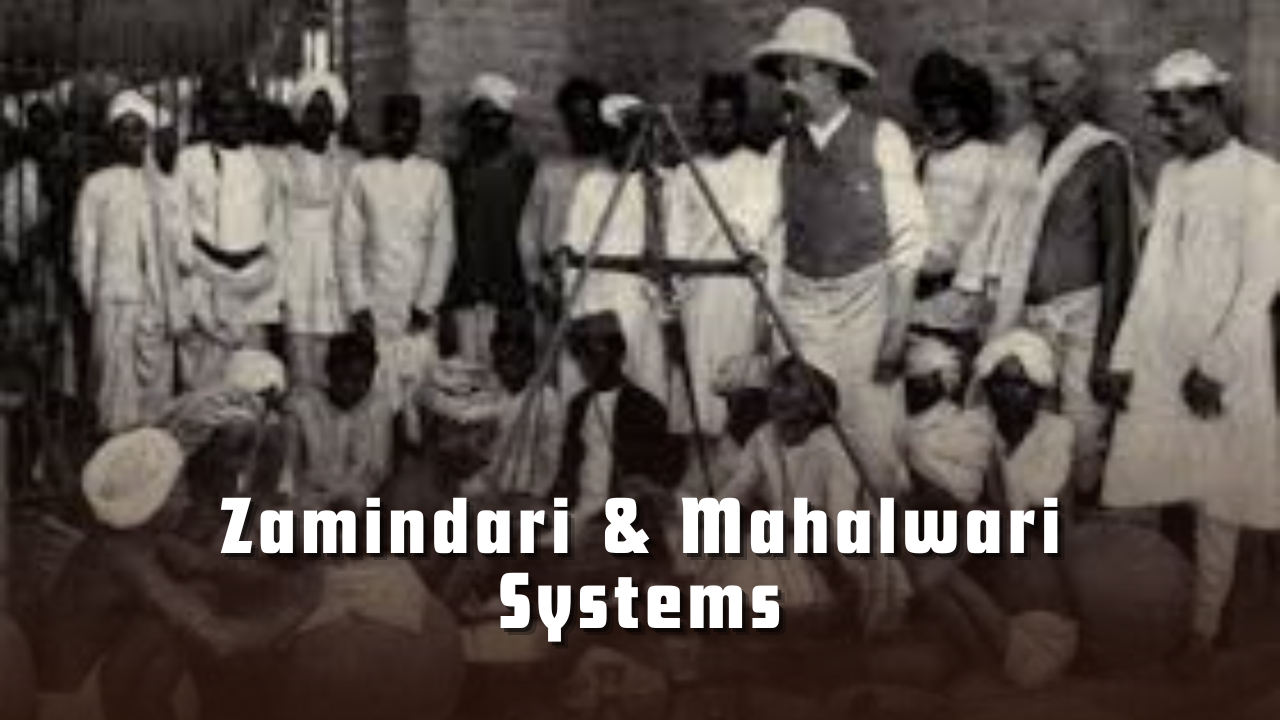Zamindari & Mahalwari Systems: Colonial Agrarian Reforms
Understand Zamindari and Mahalwari systems, their features, impact, and legacy—vital for UPSC history, agriculture, and land reform topics.

Agrarian systems are important for UPSC because these colonial land revenue systems shaped India’s rural economy, land ownership, and peasant relations. Understanding them helps explain agrarian distress during British rule and the basis for post-independence land reforms. It connects history, economics, and social issues, making it relevant for both Prelims and Mains, especially for questions on agriculture, rural development, and economic policies. Studying these systems provides essential context for India’s agrarian challenges, past and present.
Introduction
Colonial India witnessed the restructuring of the agrarian economy through a set of land revenue systems aimed at maximizing British profit while ensuring administrative convenience. The three prominent systems—Zamindari, Mahalwari, and Ryotwari—were devised to manage land revenue extraction in various regions of British India. Among them, the Zamindari and Mahalwari systems had a significant impact on the socio-economic conditions of rural India. These systems not only redefined the relationship between the cultivators and the state but also shaped the patterns of land ownership, agrarian relations, and rural hierarchies for decades to come.
Understanding these land tenure systems is critical for UPSC aspirants, especially for topics related to modern Indian history, agrarian structure, colonial economic policies, and land reforms. This detailed blog attempts a holistic analysis of the Zamindari and Mahalwari systems, tracing their evolution, features, consequences, and lasting legacy.
Pre-Independence Land Tenure Systems and Agrarian Structure
Agrarian Structure in Pre-British India
Pre-British Indian rural society was primarily organised around self-sufficient village communities centred on agriculture. These villages, often referred to as “little republics,” functioned as independent economic units that had endured for centuries with only minor changes despite the rise and fall of various kingdoms. Agricultural and allied activities were carried out using primitive tools and traditional handicrafts, reflecting a largely subsistence economy. Each village was administered by a local committee that acted as the de facto authority over land, which was distributed among peasant families in hereditary holdings passed down through generations. The village population, composed mainly of farmers, operated within a framework of collective norms and managed shared services, reinforcing the community’s autonomy and cohesion.
Land Ownership under Hindu and Muslim Rule
- Land was owned by the village community, not the king, during the period of Hindu rulers.
- The king/intermediaries claimed only a share of the agricultural produce, which was paid in kind.
- Village committees managed the collection and distribution of this produce.
- The state’s role was limited to tax collection and did not interfere with village land ownership.
- Under Muslim rulers, similar land tenure and taxation systems were continued with some modifications.
- Despite changes in rule, customary village rights over land remained intact.
Economic Features of Pre-British Agrarian Society
- The pattern of agricultural production in Indian villages remained largely consistent over centuries.
- Customary land rights of village communities were generally respected by the rulers, who rarely interfered.
- A significant portion of agricultural output was consumed within the village itself by both farming and non-farming residents, with only a small share allocated to the ruling authority.
- There was minimal exchange of goods beyond the village, as most of what was produced was used locally.
- The village population typically comprised 1) farmers, 2) Artisans and service providers such as blacksmiths, carpenters, potters, weavers, cobblers, washermen, oil pressers, and barbers
- These individuals primarily worked within the village, catering to the daily needs of the local community.
Social Features of Pre-British Agrarian Structure
Before the British conquest, India had experienced several invasions, but these mainly brought about political changes without significantly transforming the agrarian structure.
Pre-British Indian society was marked by the dominance of collective institutions over the individual, such as
- The caste system
- The family
- The village panchayat
The caste system operated with the rigidity of natural law, assigning occupations based on birth. As a result, professions became hereditary, and individuals had little personal autonomy, with their lives largely governed by caste and village norms.
Impact of British Rule on Agrarian Structure
The political and economic policies adopted by the British government after the conquest of India introduced elements of transformation in the Indian economy and society.
Impact on Village Community
- Land in pre-British India was collectively owned by the village community.
- Neither rulers nor individual cultivators held private ownership of land.
- Village institutions managed land through customary rights and collective control.
- British rule introduced the concept of private property in land.
- Traditional village rights were overridden by colonial land revenue systems.
- This shift disrupted the communal agrarian structure.
- British policies marked the start of an agrarian revolution in India.
Transformation of Land Ownership
- The British introduced the concept of private land ownership.
- This divided the village community into two distinct classes:
- Peasant landowners
- Large-scale landlords
- Led to a material transformation of agrarian society, resulting in:
- Social changes – stratification and decline of communal bonds
- Economic changes – commercialisation and monetisation of agriculture
- Political changes – emergence of new power dynamics
- Cultural and psychological shifts – erosion of collective identity and values
Decline of Panchayat Power
- The village lost its role as the supervisor and owner of agricultural activity.
- Land disputes began to be handled by British courts instead of village elders or panchayats.
- This weakened the authority and relevance of traditional village institutions like the panchayat.
Changes in Revenue and Legal Systems
- The British introduced a new land revenue system with:
- Individual landholders instead of community-held land.
- Individual assessment and taxation in place of the traditional collective assessment.
- These changes disconnected peasants from the village community, severing age-old ties and obligations.
Breakdown of Village Self-Sufficiency
- The traditional coexistence of agriculture and industry within villages was disrupted.
- The centralised colonial state took over many local functions, weakening community autonomy.
- The village was transformed:
- From a self-governing unit to a mere administrative division of the colonial system.
- From a localised, self-reliant economy to one integrated into the colonial economy.
Emergence of Competitive Individualism
- The earlier collective life based on cooperation and shared interests collapsed.
- Village society shifted towards:
- Competition
- Isolation
- Struggle among individuals
- This marked the end of traditional community-based rural life.
Changes in Land Tenure during British Rule
The British conquest of India fundamentally altered the traditional land tenure system, replacing centuries-old collective ownership with state-centric revenue arrangements and private property notions.
Background
- Initially, the East India Company struggled to sustain its trade due to:
- Low demand for British goods in India.
- Prohibition on exporting gold and silver from England to pay for Indian goods
- As a workaround, the Company began mobilising Indian revenues to finance its trade.
- A major shift occurred in 1765, when the Company was granted the Dewani (revenue collection rights) of Bengal, Bihar, and Orissa, giving it financial control over these regions.
Zamindari System (Permanent Settlement)
Historical Background
- Introduced in 1793 by Lord Cornwallis through the Permanent Settlement Act.
- Aimed at creating a class of loyal intermediaries (zamindars) who would ensure a stable revenue flow to the British.
- Initially implemented in Bengal Presidency, and later extended to Bihar, Odisha, and Varanasi.
- Based on the belief that private ownership and fixed taxes would promote agricultural improvement.
Key Features
- Zamindars recognised as hereditary landowners and intermediaries between the state and cultivators.
- Revenue fixed in perpetuity, creating long-term predictability for the British.
- Peasants (raiyats) were deprived of ownership rights and became mere tenants.
- Zamindars could lose their estates if revenue was not paid on time.
- A portion of collected revenue (around 10–11%) was retained by zamindars; the rest was passed to the East India Company.
Revenue Collection and Administrative Implications
- The state no longer dealt directly with cultivators, thereby reducing administrative costs.
- The policy encouraged absentee landlordism, as many zamindars moved to urban areas and hired agents to collect revenue.
- With no obligation to invest in land improvement, many zamindars neglected agricultural development.
Socio-Economic Consequences
- High and fixed revenue demands led to widespread evictions, especially during poor harvests.
- Zamindars extracted exorbitant rents and had the legal backing to auction lands.
- Peasants suffered from insecurity, indebtedness, and poverty.
- Little incentive to improve productivity due to fear of higher rent demands if land yield increased.
Long-Term Impact
- Consolidated landlordism in eastern India.
- Agricultural stagnation and food insecurity, including famines, worsened.
- Created a class divide in rural areas, with landless peasants and wealthy absentee landlords.
- Contributed to the rise of peasant movements in the 20th century demanding tenancy reforms.
Mahalwari System
Historical Background
- Initiated in 1822 by Holt Mackenzie and further refined in 1833 under Lord William Bentinck.
- Implemented in North-Western Provinces, Central India, Punjab, Delhi, and parts of Uttar Pradesh and Madhya Pradesh.
- Designed to correct the shortcomings of Zamindari by incorporating traditional village-based structures.
Key Features
- The Mahal (village or a group of villages) was the unit of revenue assessment.
- Revenue liability was shared collectively by the community or headmen.
- Ownership rights were often vested in the village community, including proprietary body (pattidars or lambardars).
- Revenue was revised periodically, typically every 20 to 30 years, based on reassessment.
- Aimed at combining British administrative interests with Indian village traditions.
Administrative Mechanism
- The government appointed revenue officers to survey land and fix assessments.
- Village Lambardars or headmen acted as agents for revenue collection.
- Encouraged detailed record-keeping and land measurement through settlement reports.
Social and Economic Consequences
- Revenue assessments were often excessive and did not consider seasonal variation in productivity.
- Wealthier peasants dominated the collective bodies and monopolised landownership.
- Poorer cultivators were often forced to sell or mortgage land, leading to increased land alienation.
- The debt cycle became entrenched, as peasants borrowed to pay taxes.
Long-Term Impact
- Reinforced rural stratification, with elite peasant classes gaining more control.
- Contributed to agrarian distress, especially during crop failures.
- Played a role in peasant dissatisfaction that fueled uprisings, including the Revolt of 1857.
- Created a foundation for future land reforms due to its exploitative nature.
Ryotwari System
Key Features
- Introduced in 1820 by Thomas Munro in Madras and Bombay Presidencies.
- Direct relationship between the government and cultivator (ryot).
- Ryots were recognised as owners of their lands, paying revenue directly.
- Revenue revised frequently, placing stress on cultivators.
- Promoted as more equitable, but in reality led to heavy taxation and peasant indebtedness.
Comparison Relevance
- Unlike the Zamindari system, there were no intermediaries.
- Compared to Mahalwari, it had less communal involvement.
- Despite its claim of peasant ownership, it failed to provide security or investment support.
Comparative Table: Zamindari vs. Mahalwari vs. Ryotwari
| Feature | Zamindari System | Mahalwari System | Ryotwari System |
| Region Implemented | Bengal, Bihar, Odisha | UP, Punjab, MP, Delhi | Madras, Bombay, Assam |
| Year Introduced | 1793 | 1822–1833 | 1820 |
| Revenue Collector | Zamindar | Village headman/Lambardar | Government directly from ryot |
| Ownership Recognised | Zamindar | Village community (jointly held) | Cultivator (ryot) |
| Assessment Method | Fixed permanently | Periodic revision (20–30 years) | Frequent revision |
| Revenue Burden | Very high | High and often over-assessed | High and unstable |
| Peasant Rights | Tenants-at-will | Limited, controlled by elites | Recognised but unsecured |
| Impact on Agriculture | Stagnation | Fragmentation, discontent | Debt, insecurity |
| Administrative Cost | Low for British | Moderate | High due to direct collection |
Consequences of Land Tenure Systems on Agrarian Society
Economic Dislocation
- The shift from a subsistence-based economy to a commercialised agrarian system was disruptive.
- Peasants were forced to grow cash crops for market rather than food crops.
- This made agriculture vulnerable to price fluctuations and crop failures.
Rise of Moneylenders and Land Alienation
- Tax demands pushed cultivators to borrow from moneylenders at high interest.
- Defaults led to land loss and migration.
- Moneylenders and intermediaries gained control over village economies.
Famines and Agricultural Stagnation
- Inflexible tax systems did not adjust to monsoon failures or price crashes.
- Famines like those in 1876–78 and 1899–1900 were worsened by revenue demands.
- No provision for agricultural investment or infrastructure by landlords.
Political Fallout and Resistance
- Widespread dissatisfaction gave rise to movements like:
- Pabna Revolt (1873-76) in Bengal against zamindars.
- Deccan Riots (1875) in Maharashtra against moneylenders.
- Peasant participation in the 1857 Revolt was partly driven by Mahalwari oppression.
Post-Independence Reforms
- Abolition of intermediaries via the Zamindari Abolition Acts in the 1950s.
- Introduction of land ceiling laws, tenancy reforms, and consolidation.
- Land to the tiller became the policy direction for social justice.
Relevance to UPSC Aspirants
Prelims Perspective
- Focus on factual details: who introduced the system, where, and when.
- Understand technical terms like raiyat, mahal, permanent settlement, etc.
Mains Perspective
- Analyse systemic exploitation of peasants.
- Comparative assessment of land tenure systems.
- Link these to broader issues of agrarian poverty, land inequality, and colonial economy.
Linkages with Other Themes
- Connect with economic drain theory, famines, rural unrest, and peasant movements.
- Supports essays and GS answers on land reforms and rural development.
Conclusion
The Zamindari and Mahalwari systems were central pillars of British agrarian strategy in India, driven by the logic of revenue maximisation and administrative efficiency. Though different in form—one centralised through landlords and the other community-based—they produced similar outcomes: peasant exploitation, economic hardship, and rural inequality. Their legacy outlived colonial rule and shaped post-independence land reform policies. For UPSC aspirants, a detailed understanding of these systems provides critical insights into colonial governance, rural transformation, and the socio-political economy of India.
Subscribe to our Youtube Channel for more Valuable Content – TheStudyias
Download the App to Subscribe to our Courses – Thestudyias
The Source’s Authority and Ownership of the Article is Claimed By THE STUDY IAS BY MANIKANT SINGH




